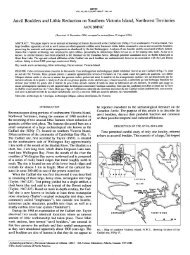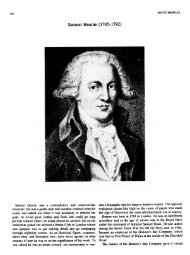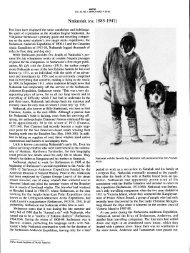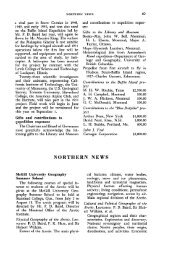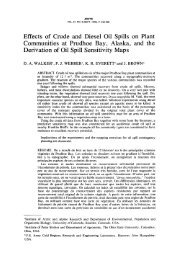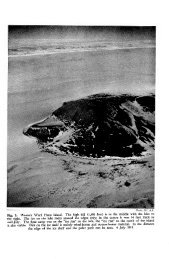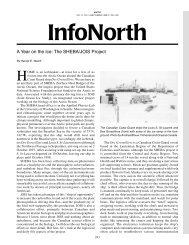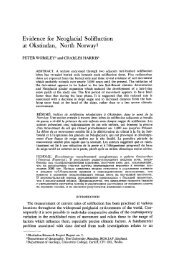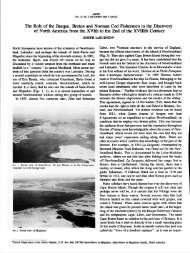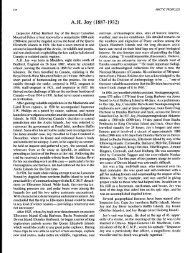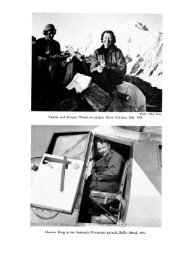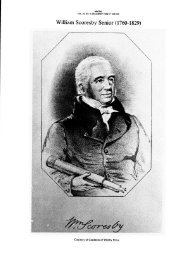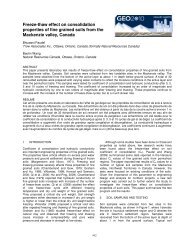NOTES ON THE NUNAMIUT ESKIMO AND MAMMALS OF ... - arctic
NOTES ON THE NUNAMIUT ESKIMO AND MAMMALS OF ... - arctic
NOTES ON THE NUNAMIUT ESKIMO AND MAMMALS OF ... - arctic
Create successful ePaper yourself
Turn your PDF publications into a flip-book with our unique Google optimized e-Paper software.
158 <strong>THE</strong> <strong>NUNAMIUT</strong> <strong>ESKIMO</strong> <strong>AND</strong> <strong>MAMMALS</strong> <strong>OF</strong> <strong>THE</strong> ANAKTUVUK PASS REGI<strong>ON</strong><br />
intradermal tuberculin test is extremely low1-in fact, one of the lowest to be<br />
found in Alaskan native communities. However, if the Nunamiut abandon<br />
their present active outdoor life, this disease may well become prevalent among<br />
them also.<br />
Historical Information<br />
The Nunamiut know themselves to have been for some generations inhabitants<br />
of the central Brooks Range, from the region of the Anaktuvuk to the<br />
Killik, and they can point out where certain of their ancestors were born in the<br />
valleys they now inhabit.<br />
Many years ago, when they were numerous and widely dispersed, they<br />
designated themselves according to the region in which they lived and hunted.<br />
Thus, there were three main groups: the Tulugakm’ut (tulugak, “raven”)the<br />
people living in the vicinity of Tulugak Lake; the Narivakvukmkt (nuiuakmk,<br />
“big lake”, Chandler Lake)-the people living near Chandler Lake;<br />
and the Kitlikmiut-the people living near the Killik River.<br />
The Nunamiut made definite seasonal migrations, connected with their<br />
hunting and trade with the coastal Eskimo. Formerly, the Tulugakmiut<br />
would go by dog team in May to the mouth of the Anaktuvuk River, where<br />
they had cached their skin boats (umiat) the previous autumn. Here they<br />
left their sleds, and after break-up took their dogs and other possessions,<br />
and travelled to the mouth of the Colville River, to a place called Nikilik (from<br />
Nikdivik, “white-fronted goose”), the Nirlik of Stefansson (1914). At Nikilik<br />
they were met by Point Barrow people, who came for the purpose of trading.<br />
In this way they obtained seal oil and seal skins, and later, articles which the<br />
coast people had traded from the whalers. In August they returned to the<br />
mouth of the Anaktuvuk, hunted and fished until freeze-up, and then returned<br />
to the mountains to spend the winter in hunting.<br />
Schrader (1904, p. 35) considered Nikilik an important settlement.<br />
Stefansson (1913; 1914) met some of the Inland People at Nikilik. The grandchildren<br />
of one of the more prominent of the Inland men, Pannioluk, mentioned<br />
frequently by Stefansson, are among the remaining Nunamiut in the Brooks<br />
Range. One of these, a young woman<br />
Pannioluk.<br />
of twenty-four, also bears the name<br />
The Kitlikmiut cached their skin boats at the head of the Ikpikpuk, to<br />
which they portaged from the mouth of the Killik. In the spring they<br />
travelled to the neighbourhood of Barrow (Otkiauik, “place of owls”) * to trade.<br />
They usually camped near the duck-hunting station, Piknik, east of Barrow<br />
Village. Late in summer they returned south and came back to the Killik<br />
after freeze-up. I do not know which route was taken by the Narivakvukmiut.<br />
Winters were spent in hunting, and the Nunamiut moved according to<br />
the caribou migrations, never staying long in one place. The Kobuk people<br />
1This test was administered by Dr. Wendell C. Mathews, Tuberculosis Consultant,<br />
Alaska Department of Health, and myself during early September 1951. At this time we<br />
vaccinated all non-reactors against tuberculosis by the BCG method.<br />
2According to Mr. David Brower, of Barrow Village, this name is correctly Okpiavik<br />
(from okpik, “snowy owl”, and uik, “place”), but was changed to the present form during<br />
his father’s time.



